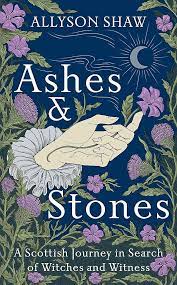Ashes & Stones: A Scottish Journey in Search of Witches & Witness
Allyson
Shaw is an American of Scottish background who moved to the north of Scotland
15 years before writing this book, which seeks to find out more about the
witch-hunts in Scotland. She spent a few years “visiting monuments to accused
witches – the stones, fountains and even hedge mazes dedicated to people who
were accused during the witch-hunts of the sixteenth and seventeenth centuries.
Secreted away outside a village here, beside a suburban lawn there, each has
its own story.” Each chapter of the book focuses on one of those stories.
The
witch-hunts in Scotland lasted for almost 200 years, with approximately 4,000
people officially accused and over 2,000 executed. As Shaw writes, “Considering
the small population of Scotland in the seventeenth century (approximately
800,000 people), these numbers are sobering.”
In
writing this book, Shaw says, “I want an authentic glimpse of these women
accused of witchcraft, and I go out into the landscape to meet them. My
research accumulates, and the scope of atrocity deepens. Everywhere, it seems,
is evidence of these mass, state-sanctioned killings. The hunts terrorized
generations, and the overwhelming majority of the victims were women.”
Shaw
has gathered material from so-called ‘witches confessions’ in court and church
records, local legends and references in later works, commenting on the content
from a 21st century viewpoint. Interspersed among this information, she
refers to her own life with its story of early sexual abuse, difficult family
relationships, chronic illnesses and her search for her place in the world.
It
was near impossible to find out information about specific women, other than
their names in the records of executions, so Shaw tries to fill in the gaps
with clues from the landscape and history of the places where they were killed.
She also tries to separate local legend from what is known as fact. Her
research for such meager information is impressive. In some cases she quotes
from the trial records and from the confessions, while also giving her
assumptions of why the women created the stories they told. She adds descriptions
of the landscape and the specific locations of executions that she visits
throughout the northeast of Scotland. These descriptions are specific and rather
lyrical. In describing her search for the grave of Lillias Adie, who was
executed in Torryburn in 1704, she writes:
“Back
beside the car park, I see her grave at the foreshore, much closer than I’d
imagined it would be. Lillias’s grave is doorstop-sized, wreathed with frills
of black bladderwrack. It is a stone trapdoor to some unkind realm. I stand
before it and wonder why the sea hasn’t taken it away, swallowed it up
entirely. The water comes and goes gently, rises almost without movement. A
deep patience resides in this place. Perhaps it has something to teach me about
justice – changes in attitudes and ideas are made in tenuous increments. At the
high shore, just as I’m leaving, I spot a cluster of Cirsium heterophyllum, a flower with the common name ‘melancholy
thistle’. One fluffy flowerhead nods with the weight of a bee rumbling through
its petals. It was once thought that this flower could cure melancholy. Maybe
Lillias knew of it. It strikes me – she is not here. She’s not beneath the mud;
her coffin and bones were robbed from her grave over a century ago. Nor is she
in the heritage signs or ghost stories. She’s gone, and it’s the living that
must wrestle with the truth of her death.”
Much
of the book is information about how women were targeted as witches, the
tortures that were used to force them to confess, and the methods used to
completely erase not only their bodies but the memory of them. This information
seemed to get rather repetitive, especially because I had thought much of it
was common knowledge. Perhaps the problem for me was that I already knew about
the witch trials in Europe and in Salem, USA. I knew the behaviors that could
result in accusations of witchcraft, that confessions were extracted under
torture, what the tortures were, how the accused were executed (in Scotland,
first strangled then burnt to ashes). So these aspects weren’t new for me. But
connecting the women and their stories to the landscape they lived in was a new
way of thinking about this history.
Although
I found her descriptions very engaging, it wasn’t clear to me what she hoped to
achieve in this book. It seemed to be a very personal search to her. She refers
to herself as a ‘witch,’ but doesn’t indicate which kind she means or how this
is relevant to her search. And by the end of the book, I didn’t know if she had
found what she was looking for or had achieved what she had hoped to. In any
case, the book focuses on witch-hunts and its persecution of women in a way
that I had never read before. For that reason, I’m glad I found this book.


I’m glad you found an element you enjoyed, Thanks for sharing your thoughts
ReplyDeleteIt's certainly an unusual approach to this topic. Thanks for your comment!
ReplyDelete